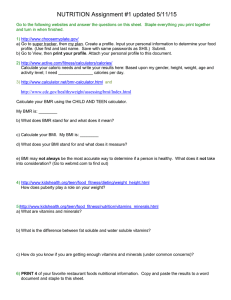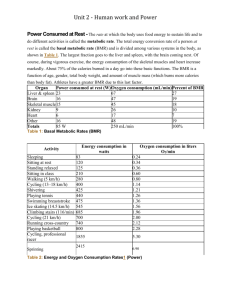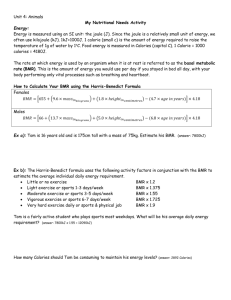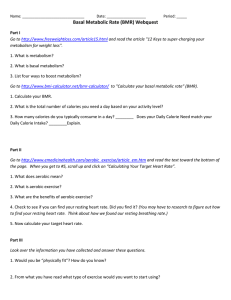File
advertisement
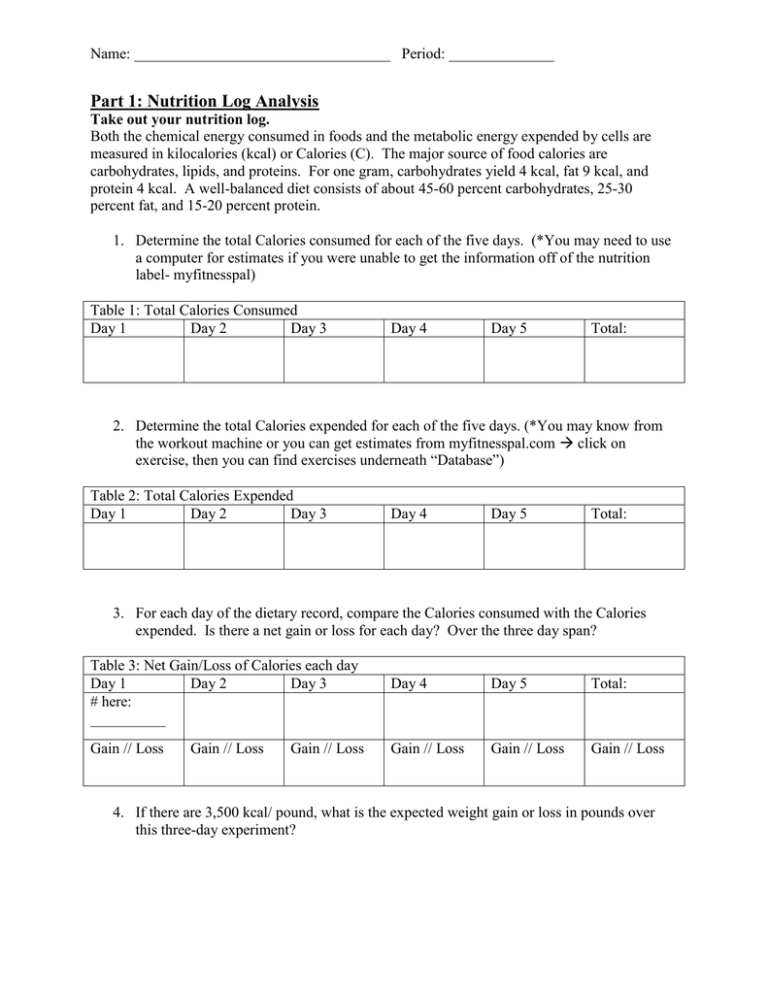
Name: __________________________________ Period: ______________ Part 1: Nutrition Log Analysis Take out your nutrition log. Both the chemical energy consumed in foods and the metabolic energy expended by cells are measured in kilocalories (kcal) or Calories (C). The major source of food calories are carbohydrates, lipids, and proteins. For one gram, carbohydrates yield 4 kcal, fat 9 kcal, and protein 4 kcal. A well-balanced diet consists of about 45-60 percent carbohydrates, 25-30 percent fat, and 15-20 percent protein. 1. Determine the total Calories consumed for each of the five days. (*You may need to use a computer for estimates if you were unable to get the information off of the nutrition label- myfitnesspal) Table 1: Total Calories Consumed Day 1 Day 2 Day 3 Day 4 Day 5 Total: 2. Determine the total Calories expended for each of the five days. (*You may know from the workout machine or you can get estimates from myfitnesspal.com click on exercise, then you can find exercises underneath “Database”) Table 2: Total Calories Expended Day 1 Day 2 Day 3 Day 4 Day 5 Total: 3. For each day of the dietary record, compare the Calories consumed with the Calories expended. Is there a net gain or loss for each day? Over the three day span? Table 3: Net Gain/Loss of Calories each day Day 1 Day 2 Day 3 # here: __________ Gain // Loss Gain // Loss Gain // Loss Day 4 Day 5 Total: Gain // Loss Gain // Loss Gain // Loss 4. If there are 3,500 kcal/ pound, what is the expected weight gain or loss in pounds over this three-day experiment? Name: __________________________________ Period: ______________ 5. Study your dietary and activity record. Make a detailed list of at least four specific suggestions for improving your diet and activity. Suggestion Why? (Cite data from above) Part 2:Energy Output: BMR and Activity The total energy expended each day includes the energy consumed at rest and during physical activity. The basal metabolic rate (BMR) is a measure of the energy required to maintain the body. Procedure: A. Determine your BMR by the following methods: 1. The Harris-Benedict formula (BMR based on total body weight) The Harris Benedict equation is a calorie formula using the factors of height, weight, age, and sex to determine basal metabolic rate (BMR). This makes it more accurate than determining calorie needs based on total bodyweight alone. The only variable it does not take into consideration is lean body mass. Therefore, this equation will be very accurate in all but the extremely muscular (will underestimate caloric needs) and the extremely overfat (will overestimate caloric needs). Men: BMR = 66 + (13.7 X wt in kg) + (5 X ht in cm) - (6.8 X age in years) Women: BMR = 655 + (9.6 X wt in kg) + (1.8 X ht in cm) - (4.7 X age in years) Note: 1 inch = 2.54 cm. ; 1 kilogram = 2.2 lbs. BMR: ____________ Name: __________________________________ Period: ______________ 2. Katch-McArdle formula (BMR based on lean body weight): If you have had your body composition tested and you know your lean body mass, then you can get the most accurate BMR estimate of all. This formula from Katch & McArdle takes into account lean mass and therefore is more accurate than a formula based on total body weight. The Harris Benedict equation has separate formulas for men and women because men generally have a higher LBM and this is factored into the men's formula. Since the Katch-McArdle formula accounts for LBM, this single formula applies equally to both men and women. Go to http://www.healthstatus.com/calculate/lean-body-mass to calculate an estimate of LBW. BMR (men and women) = 370 + (21.6 X lean mass in kg) BMR: ____________ Are the two estimates similar? B. Determine your energy expenditure for each day by multiplying your BMR by the appropriate daily activity multiplier below. My energy expenditure is: ______________________________ Activity Multiplier Sedentary = BMR X 1.2 (lay in bed all day; no exercise) Lightly active = BMR X 1.375 (normal daily activity no exercise/sports) Mod. active = BMR X 1.55 (normal daily activity 1 hr exercise/sports) Very active = BMR X 1.725 (normal daily activity 2 hrs hard exercise/sports) Extremely active = BMR X 1.9 (normal daily activity 4 hrs rigorous athletic training) What do you notice about this number? Name: __________________________________ Period: ______________ Part 3: BMI Body mass index, or BMI, is a new term to most people. However, it is the measurement of choice for many physicians and researchers studying obesity. BMI uses a mathematical formula that takes into account both a person's height and weight. BMI equals a person's weight in kilograms divided by height in meters squared. (BMI=kg/m2). Risk of Associated Disease According to BMI and Waist Size BMI 18.5 or less 18.5 - 24.9 25.0 - 29.9 30.0 - 34.9 35.0 - 39.9 40 or greater Underweight Normal Overweight Obese Obese Extremely Obese Calculate your BMI . (Kg / (Ht)2). Waist less than or equal to 40 in. (men) or 35 in. (women) --Increased High Very High Extremely High Waist greater than 40 in. (men) or 35 in. (women) N/A N/A High Very High Very High Extremely High ________________ What is your risk of disease? Summary Questions (will be discussed): 1. What was a key fact that you learned about your diet or exercise habits? 2. Which numbers stuck out to you the most from your calculations? 3. How do you think as a school we could improve our diet and nutrition habits?


